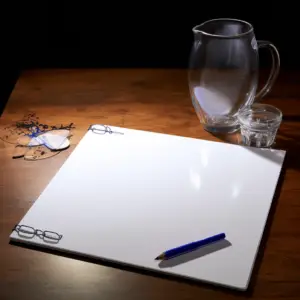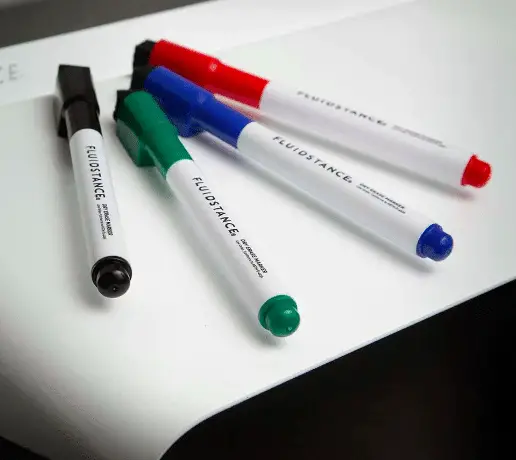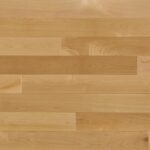Dry erase are high-quality markers that work on whiteboards and some other surfaces. They are fully functional and comfy to use. You can use the dry-erase markers to make drawings, calculations, writings, and designs or even to teach your child their favourite subject.
Table of Contents
Does Dry Erase Work on Glass: An Explanation

Most people always ask, can you use dry erase on glass? Yes. According to previous users of dry erase, the markers work well on glass, especially the window glass panes. Therefore, you can grab your Dry erase marker and write something in your living room or toilet window. Still, you can write reminders or any other suggestions on the toilet mirrors and windows.
Some markers are quite great when it comes to the non-porous surface, and a Dry erase marker is among them. So you can use the Dry erase on the glass sliding door or windows. In addition, if you want to use a glass material as a whiteboard, Dry erase markers will still work.
Clearing whatever Dry erase markers have been painted on the glass is easy. You can use materials such as acetone, alcohol, methyl ethyl ketone, or even the fingernail polish remover. A slightly wet paper towel also works effectively in removing the marks of dry erase on glass.
Can You Use Dry Erase On Laminated Papers?
Melamine is applied to laminated papers and then dried, creating a durable paper composite. That means that laminated paper is a non-porous surface compatible with dry-erase markers.
However, Dry erase markers are challenging to remove from laminated paper. You should not allow the ink of a Dry erase marker to dry up fully on laminated papers; otherwise, they will become difficult to remove.
On the other hand, the magic eraser may be used to remove the Dry erasepaint from laminated paper successfully. Rubber alcohol is another ideal alternative.
Can Glass Be Used As a Whiteboard?
Yes. Glass has become the perfect material for whiteboards, but mounting a piece of ordinary glass on a wall is not recommended. Your DIY glassboard might become the source of endless problems due to sharp edges, shoddy installation, and poor back painting.
Can You Use Dry Erase Markers On Wine Glasses?
For a few years, wine charms were very popular since they made wine glass identification easy. A cheap and simple approach to keeping track of your wine glass is to write your initials on the base using a thin Dry erase marker.
Will Dry Erase Markers Come Off Mirrors?
Yes. Dry erase markers are allowed to be used on mirrors. They are a household favorite since they are simple to clean up. To easily wipe it off, you only need a soft material like cotton, fabric, or paper towels.
Are Dry Erase Markers Permanent?
When you apply dry erase on any material that absorbs liquids, for example, paper or fabric, dry-erase markers become permanent. Fortunately, dry erase markers are made from resin, SD alcohol-40, and isopropanol, the chemicals that make them temporary on the non-porous surface, such as glass. Therefore Dry erase markers are not permanent on glass.
What Are the Constituents of Dry Erase Markers?
The most common writing instrument for any whiteboard is the Dry erase marker. In addition, it’s used on various non-porous surfaces, overhead projector film, and signboards. One may erase the Dry erase markers. However, they will become permanent if you utilize non-porous materials like fabric or paper.
Now, what makes up the dry erase? Three different compounds, including SD alcohol 40, isopropanol, and resin, are present in these markers. It also contains highly flammable isopropanol, also known as isopropyl alcohol.
Because of this, you shouldn’t hold these markers close to a flame. Additionally, avoid breathing in Dry erase marker fumes because they pose a health risk.
A type of alcohol found in Dry erase markers is the SD alcohol 40, also known as the specifically denatured alcohol 40. SD alcohol 40 is frequently used in alcoholic beverages, home goods, and cosmetics apart from the Dry erase markers
Resin is soluble in alcohol and is derived from plants. It melts when combined with the other compounds included in Dry erase markers. These chemicals used to make the Dry erase markers makes it easy for you to remove them using ordinary water or alcohol.
What Are Some Factors You Need To Consider When Buying Markers?

You have a glass board installed on the wall, what kind of glass marker will you use to write on it? You have a lot of alternatives to consider knowing that others are better while others are a nightmare. When choosing markers, the following factors should be taken into account:
- Color: Markers can be found in plain colors, neon tones, and even metallic hues. You should employ a variety of vibrant colors to create presentations that are eye-catching and aesthetically intriguing. From a distance, bright, vivid colors used in broad strokes are easier to see.
- Tip: What will you primarily utilize the glass board for? Storyline? Explicit drawings? Well, the size of the tip affects the stroke size. The bullet tip with a stroke width of 2 to 3 mm is the most widely used. The chisel tip’s three-stroke widths may create a range in size from 2 to 5 mm. A 1 mm stroke width is produced by the fine or the extra-fine tip.
- Longevity: Different markers dry out at different rates. Some markers may have weaker ink that dries off more quickly.
Wrap Up
Dry erase markers are incredibly helpful. However, you must be aware of where to use them. Dry erase markers shouldn’t be applied to porous surfaces or have a high ink absorption rate.
Therefore, you can use dry erase on glass. Other non-porous surfaces comparable to glass include mirrors, laminated paper, and window panes. In the laboratory, some people use Dry erase markers to write on any glass-based items.
Additionally, they are simple to get rid of using several products, including nail polish remover, acetone, and rubbing alcohol.


